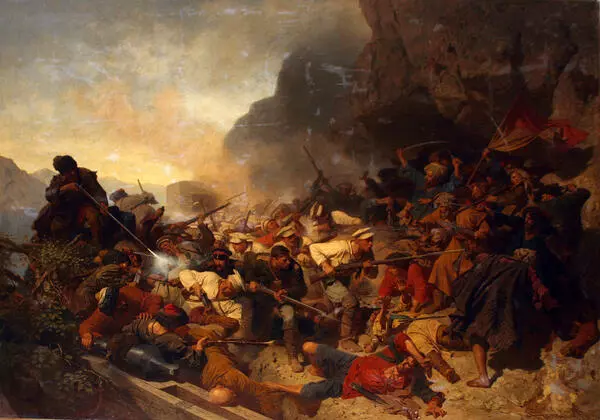Theodor Horschelt (1829 — 1871) was a German painter who from an early age dreamed about the Caucasus, which in his imagination was a “fairy-tale land”. He came there for the first time in 1858 as a volunteer to the headquarters of Prince Baryatinsky, the commander-in-chief of the Caucasian army. The painter did not shirk the army life: in fact, for five years he was in battle and was decorated with Russia’s orders of Saint Stanislaus and of St. Anna for valour.
Prince Baryatinsky’s Horse
Creation period
1861
Dimensions
43x55 cm
Technique
Oil on canvas
Collection
Exhibition
3
Open in app#1
Theodor Horschelt
Prince Baryatinsky’s Horse
#2
#8
Having returned to Munich in 1863, Horschelt noted in his diary:
‘The bravery of fighters, their wild, indomitable appearance, their villages and rocks, their fast rivers, their legends and histories — it all makes for poetry’.
#7
The artist happened to be participant in and witness of a few major episodes of the Caucasian war. He was at the assault of Vedeno and Gunib, the two residences of Imam Shamil, and witnessed the capture of the legendary Caucasian leader.
Subsequently Horschelt made a series of drawings based on his Caucasian memories, while the sketches that he did in Gunib fed into a large canvas about the capture of Shamil, displayed in Munich in 1869, then in Petersburg. Later it was delivered to Maryino to the customer.
#4
Emperor Alexander II acquired many of his drawings; he donated them to the St. Petersburg Imperial Academy of Arts that awarded Horschelt the title of the academician.
#5
T. Horschelt. Captured Shamil before Commander-in Chief Prince A.I. Baryatinsky in Gunib 25 August 1859. 1863. Source: A. Takho-Godi National Museum of the Republic of Dagestan
#9
P.S. Gamzatova Dagestan Museum of Fine Arts has on its display Prince Baryatinsky’s Horse of 1861. It is known that Prince Baryatinsky was a passionate lover of horses and repeatedly commissioned “ceremonial portraits” of his pets. Since youth he was a keen bare-back rider and a fan of races for which he acquired the most expensive horses.
Although the painter believed battle scenes to be “the best type of painting”, he was equally good at more intimate works. Horschelt never lost his academic skills, and in Count Baryatinsky’s Horse we see the importance that the artist attached to perfection in drawing and composition. Showing the commander-in-chief’s horse, he renders the setting in great detail and depicts his model thoroughly. The painting is distinguished by accuracy and most fine details. Prince Baryatinsky prized Horschelt’s work for his perfectionism.
#6
He became famous for his canvas Capture of Shamil (1863). ‘The entire Munich for a whole week strove to get into the artist”s studio where the painting was put on display, ” wrote the art critic Adrian Prakhov about it. The work was honoured with the Gold Medal at the Paris World Exhibition. Today it is exhibited in the “National Museum of the Republic of Dagestan named after A. Tahoe-Godi” in Makhachkala.
#10
P.S. Gamzatova Dagestan Museum of Fine Arts
read morehide
00:00
00:00
1x
Prince Baryatinsky’s Horse
Creation period
1861
Dimensions
43x55 cm
Technique
Oil on canvas
Collection
Exhibition
3
Open in app
Share





